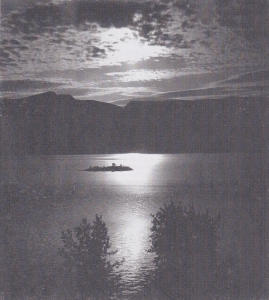“The island [in Okanagan Lake] that many still call Whiskey Island has a colourful history. Legend has it that Interior Salish stored food and supplies on the Island in order to keep it safe from bears. Squaws who were left in charge were sometimes abducted by raiding Shuswap Indians, so it was customary to place a guard on the hillside to watch up the lake and signal braves who might be hunting and fishing. They called the island Nahun Wenox, meaning ‘child of the rock’, and believed that it had once been part of the large rock just north of Nahun, across the lake to the south west….

Sydney Herbert Plummer acquired a Crown Grant to the island on April 10, 1908…. [A]t some point Henry Irvine, from the well-known Irvine family of Oyama, traded Plummer 450 acres of steep hillside to the west of Wood Lake for the island. From handwritten notes on old papers, it appears that Henry believed taxes were not payable on Crown-granted land and unfortunately only later discovered his error. Soon afterwards, the property was acquired by Clement Fisher Costerton, one-time mayor of Vernon, most likely for payment of the back taxes.
Upon CF’s death in 1930, his property had to be handled by his executors, son-in-law Albert E. Berry and son John Costerton, neither of whom had seen the island…. They eventually sold the island to Joseph Cools, who bought Okanagan House on the Carr’s point in the mid-thirties. The negotiated selling price was two bottles of Scotch Whiskey — one for each of them, and the name Whiskey Island came into being….
When the North Okanagan Naturalists Foundation acquired the island, they renamed the property to honour James Grant, a highly respected naturalist and teacher of natural history from Lavington, BC, who died in 1986. A covenant has been placed on the property to keep it in its natural state, and BC Parks and local birders monitor activity.
This small island is home to a sizeable nesting colony of Ring-billed Gulls. Three other gull species are known to nest there: California Gull, Herring Gull and Glaucous-winged Gull. It is believed that this gull colony came into existence shortly after the Kelowna City dump on Glenmore Road was established. Prior to that it was a common nesting site for Canada Geese which raised their young amongst the stunted trees and bushes that covered the rocks [of this small island, now locally known as Gull Island.]”
Source: Baughen, Penny. Carr’s Landing. A History. Vernon, BC: Carr’s Landing Community & Recreation Association, 2006.
Photograph: The island circa 1913 from the photographic collection of Arthur Fleetwood Milne Wilson.







isabel pritchard
I am enjoying your posts so much. Thank you.
Lake Country Museum
Thanks for the feedback, Isabel. There are many more interesting historical facts to come!